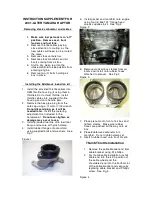
Children can be killed or seriously injured by
an inflating air bag. Note the following
important information when circumstances
require you to place a child in the front
passenger seat:
R
Your vehicle is equipped with air bag
technology designed to deactivate the front
passenger front air bag in your vehicle
when the system senses the weight of a
typical 12-month-old child or less along
with the weight of a standard appropriate
child restraint on the front passenger seat.
R
For children larger than the typical
12-month-old child, the front passenger
front air bag may or may not be activated.
Always make sure the
45
indicator
lamp is illuminated, indicating that the front
passenger front air bag is deactivated.
R
A child in a rear-facing child restraint on the
front passenger seat will be seriously
injured or even killed if the front passenger
front air bag inflates in a collision which
could occur under some circumstances,
even with the air bag technology installed
in your vehicle. The only means to
completely eliminate this risk is to never
place a child in a rear-facing child restraint
in the front seat. We therefore strongly
recommend that you always place a child
in a rear-facing child restraint in a backseat.
R
If you must install a rear-facing child
restraint on the front passenger seat
because circumstances require you to do
so, make sure the
45
indicator lamp
is illuminated, indicating that the front
passenger front air bag is deactivated.
Should the
45
indicator lamp not
illuminate or go out while the restraint is
installed, please check installation.
Periodically check the
45
indicator
lamp while driving to make sure the
45
indicator lamp is illuminated. If
the
45
indicator lamp goes out or
remains out, do not transport a child on the
front passenger seat until the system has
been repaired.
A child in a rear-facing child restraint on the
front passenger seat will be seriously
injured or even killed if the front passenger
front air bag inflates.
R
If you have to place a child in a forward-
facing child restraint on the front passenger
seat, move the seat as far back as possible,
use the proper child restraint
recommended for the age, size and weight
of the child, and secure child restraint with
the vehicle’s seat belt according to the child
seat manufacturer’s instructions.
G
Warning!
Infants and small children should never share
a seat belt with another occupant. During an
accident, they could be crushed between the
occupant and seat belt.
A child’s risk of serious or fatal injuries is
significantly increased if the child restraints
are not properly secured in the vehicle and/
or the child is not properly secured in the child
restraint.
Children too big for a toddler restraint must
ride in seats using regular seat belts. Position
shoulder belt across chest and shoulder, not
face or neck. A booster seat may be
necessary to achieve proper seat belt
positioning for children over 41 lb (18 kg) until
they reach a height where a lap/shoulder belt
fits properly without a booster.
When the child restraint is not in use, remove
it from the vehicle or secure it with the seat
belt to prevent the child restraint from
becoming a projectile in the event of an
accident.
Occupant safety
55
Safety and security
207_AKB; 2; 35, en-US
d2ureepe,
Version: 2.11.8.1
2009-07-17T07:10:21+02:00 - Seite 55
Z
Содержание 2010 E-Class Coupe
Страница 1: ...E Class Coup Operator s Manual...
Страница 4: ......
Страница 26: ...24...
Страница 70: ...68...
Страница 294: ...292...
Страница 309: ...307...
Страница 310: ...308...
Страница 312: ...Order no 6515 3716 13 Part no 207 584 27 81 Edition B 2010 2075842781 2075842781...
















































